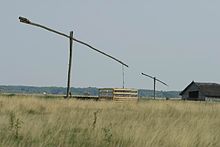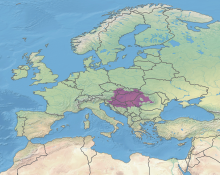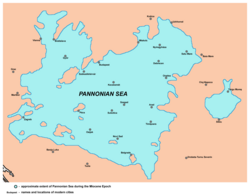| This article needs additional citations for verification. Please help improve this article by adding citations to reliable sources. Unsourced material may be challenged and removed. Find sources: "Pannonian Basin" – news · newspapers · books · scholar · JSTOR (August 2024) (Learn how and when to remove this message) |




The Pannonian Basin or Carpathian Basin is a large sedimentary basin situated in southeast Central Europe. After the Treaty of Trianon following World War I, the geomorphological term Pannonian Plain became more widely used for roughly the same region, referring to the lowlands in the area occupied by the Pannonian Sea during the Pliocene Epoch. "Pannonian Plain" term being considered not only unhistorical but also topologically erroneous term.
Terminology
| This section does not cite any sources. Please help improve this section by adding citations to reliable sources. Unsourced material may be challenged and removed. (April 2023) (Learn how and when to remove this message) |
The term Pannonian Plain refers to the lowland parts of the Pannonian Basin as well as those of some adjoining regions like Lower Austria, Moravia, and Silesia (Czech Republic and Poland). The lands adjoining the plain proper are sometimes also called peri-Pannonian.
In English language, the terms "Pannonian Basin" and "Carpathian Basin" are used synonymously. The name "Pannonian" is taken from that of Pannonia, a province of the Roman Empire. The historical province overlapped but was not coterminous with the geographical plain or basin, as only the western part of the territory (known as Transdanubia) of modern Hungary formed part of the ancient Pannonia, while Great Hungarian Plain was not part of it:
In terms of modern state boundaries, the Pannonian Basin centres on the territory of Hungary, which lies entirely within the basin, but it also covers parts of southern Slovakia, southeast Poland, western-southwest Ukraine, western Romania, northern Serbia, northeast Croatia, northeast Slovenia, and eastern Austria.
The term Carpathian Basin is used in Hungarian literature, while the West Slavic languages (Czech, Polish and Slovak), the Serbo-Croatian, German and Romanian languages use Pannonian Basin (in Hungarian the basin is known as Kárpát-medence, in Czech; Panonská pánev, in Polish; Panoński Basen, in Slovak; Panónska panva, in Slovenian and Serbo-Croatian: Panonski bazen/Панонски базен, in German; Pannonisches Becken, and in Romanian; Câmpia Panonică or Bazinul Panonic). The East Slavic languages, namely Ukrainian, use the terms Tysa-Danube Lowland or Middanubian Lowland (Ukrainian: Тисо-Дунайська низовина, Середньодунайська низовина)
Roman province of Pannonia

- Pannonia Inferior covered much of the western half of the basin, as far as the Danube.
- Pannonia Superior included the western fringe of the basin as well as part of the Eastern Alps, as far as Virunum. The southern fringe of the basin was in Dalmatia and Moesia.
- The eastern half of the basin was not conquered by the Romans and was considered part of Sarmatia, inhabited by the Iazyges. Likewise, the parts north of the Danube (now in western Slovakia) were not in the empire; they were considered part of Germania, inhabited by the Quadi.
Pannonian basin vs Carpathian basin: On the territory of present-day Hungary the ancient Roman Pannonia province was located only on Transdanubian territories, however the Great Hungarian Plain was not part of Pannonia province. This comprises less than 29% of modern Hungary, therefore Hungarian geographers avoid the terms "Pannonian Basin" and especially the "Pannonian Plain" terms due to it being considered not only unhistorical but also topologically erroneous term. Because the term "Pannonian" has historically not applied to 80% of the basin's territory, Hungarian geographers and historians use the more accurate term "Carpathian Basin". The other logical problem with the Pannonian "Plain" terminology lies in topography: with the exception of Little Hungarian Plain (which is only around 15% of the territory of ancient Pannonian Transdanubia) hills and mountains dominate the landscape, so real plains are very rare on that territory. The largest plain of Ancient Roman Pannonia province is located in Slavonia in Croatia and Voivodine in modern Serbia.
Etymology
Further information: Pannonii and Carpi peopleJulius Pokorny derived the name Pannonia from Illyrian, from the Proto-Indo-European root *pen-, "swamp, water, wet" (cf. English fen, "marsh"; Hindi pani, "water").
The name "Carpates" is highly associated with the old Dacian tribes called "Carpes" or "Carpi" who lived in a large area from the east, northeast of the Black Sea to the Transylvanian Plain in present day Romania and Moldova. The name Carpates may ultimately be from the Proto Indo-European root *sker-/*ker-, which meant mountain, rock, or rugged (cf. Germanic root *skerp-, Old Norse harfr "harrow", Gothic skarpo, Middle Low German scharf "potsherd", and Modern High German Scherbe "shard", Old English scearp and English sharp, Lithuanian kar~pas "cut, hack, notch", Latvian cìrpt "to shear, clip").
The archaic Polish word karpa meant 'rugged irregularities, underwater obstacles/rocks, rugged roots, or trunks'. The more common word skarpa means a sharp cliff or other vertical terrain. The name may instead come from Indo-European *kwerp 'to turn', akin to Old English hweorfan 'to turn, change' (English warp) and Greek καρπός karpós 'wrist', perhaps referring to the way the mountain range bends or veers in an L-shape.
Geography



Both the plain and the basin overlap significantly with the Pannonian mixed forests ecoregion.
The plain or basin is diagonally bisected by the Transdanubian Mountains, separating the larger Great Hungarian Plain (including the Eastern Slovak Lowland) from the Little Hungarian Plain. It forms a topographically discrete unit set in the European landscape, surrounded by imposing geographic boundaries—the Carpathian Mountains to north and east, the Dinaric Alps to south and southwest and the Alps to west. The plain is also associated with Pannonian Steppe.
The Danube and Tisza rivers divide the basin roughly in half. It extends roughly between Vienna in the northwest, Košice in the northeast, Zagreb in the southwest, Novi Sad in the south and Satu Mare in the east. The Danube enters the basin from its northwest through a valley that splits the Alps and the Bohemian Forest. It runs through the center of the basin escaping at southeast portion where South Carpathians transition to Dinaric Alps and Balkan Mountains. The Tisza enters the basin from northeast running downhill from the Eastern Carpathians, it continues southwest and south until joins the Danube at southern portion of the basin. Another important river of the region is Sava which running along the eastern foothills of the Dinaric Alps together with the Danube forms a conditional northern limit of Balkan peninsula. It also enters the Danube at southern portion of the Pannonian Basin. Other rivers include Drava, Mureș, Great Morava, Drina and many others. In western portion of Pannonia is located Lake Balaton.
Climate and natural resources

Although rain is not plentiful, the plain is a major agricultural area. It is sometimes said that these fields of rich loamy loess soil could feed the whole of Europe. However, there has been an increase in extreme precipitation events that cause soil erosion in recent years. Knowledge of areas affected by severe soil erosion can lead to the implementation of effective measures to reduce it.
For its early settlers, the plain offered few sources of metals or stone. When archaeologists come upon objects of obsidian or chert, copper or gold, they have almost unparalleled opportunities to interpret ancient pathways of trade.
Geomorphology

The Pannonian Basin is a geomorphological subsystem of the Alps-Himalaya system, specifically a sediment-filled back-arc basin which spread apart during the Miocene.
The Pannonian plain is divided into two parts along the Transdanubian Mountains (Hungarian: Dunántúli-középhegység). The northwestern part is called Western Pannonian plain (or province) and the southeastern part Eastern Pannonian plain (or province). They comprise the following sections:
- Western Pannonian Plain (province):
- Eastern Pannonian Plain (province):
- Great Hungarian Plain
- Pannonian Island Mountains (Serbian: Panonske ostrvske planine)
- Transdanubian Mountains (Hungarian: Dunántúli-középhegység)
- Drava–Mura lowlands
Note: The Transylvanian Plateau and the Lučenec-Košice Depression (both parts of the Carpathians) and some other lowlands are sometimes also considered part of the Pannonian Plain in non-geomorphological or older divisions.
Regions
Relatively large or distinctive areas of the plain that do not necessarily correspond to national borders include:
- Bačka/Bácska (Serbia, Hungary)
- Banat (Romania, Serbia, Hungary)
- Baranya/Baranja (Hungary, Croatia)
- Burgenland (Neusiedler Basin), Austria
- Crişana (Hungary, Romania)
- Great Hungarian Plain (Hungary, Croatia, Serbia, Slovakia, Romania, Ukraine)
- Jászság (Hungary)
- Kunság (Hungary)
- Little Hungarian Plain (Kisalföld/Malá dunajská kotlina – Hungary, Slovakia)
- Mačva (Serbia)
- Međimurje (Croatia)
- Moravia (part), Czech Republic
- Moslavina (Croatia)
- Podravina (Croatia, Hungary, around Drava river)
- Podunavlje (Serbia, Croatia, around Danube river)
- Pokuplje (Croatia, around Kupa river)
- Pomoravlje (part), Serbia, around Morava river
- Pomorišje (Romania, Hungary, Serbia, around Mureș river)
- Posavina (Croatia, Bosnia and Herzegovina, Serbia, around Sava river)
- Potisje (Serbia, around Tisa river)
- Prekmurje (Slovenia)
- Semberija (Bosnia and Herzegovina)
- Slavonia (Croatia)
- Srem/Srijem (Serbia, Croatia)
- Zakarpattia Lowland (Ukraine)
- Transdanubia (Hungary)
- Vienna Basin (part), Austria
- Vojvodina (Serbia)
- several more inside Hungary, see: Counties of Hungary, Regions of Hungary
- several more inside Slovakia, see: Traditional regions of Slovakia, Regions of Slovakia
History
Prehistory

The Pannonian Basin has its geological origins in the Pannonian Sea, a shallow sea that reached its greatest extent during the Pliocene Epoch, when three to four kilometres of sediments were deposited.
Antiquity
Main article: PannoniaThe plain was named after the Pannon named Medes. Various different peoples inhabited the plain during its history. In the first century BC, the eastern parts of the plain belonged to the Dacian state, and in the first century AD its western parts were subsumed into the Roman Empire. The Roman province named Pannonia was established in the area, and the city of Sirmium, today Sremska Mitrovica, Serbia, became one of the four capital cities of the Roman Empire in the 3rd century.
Middle Ages
| This section does not cite any sources. Please help improve this section by adding citations to reliable sources. Unsourced material may be challenged and removed. (July 2022) (Learn how and when to remove this message) |
In the Age of Migrations and the early Middle Ages, the region belonged to several realms such as the Hun Empire, the Kingdom of the Gepids, the Kingdom of the Ostrogoths, the Kingdom of the Lombards, the Avar Khaganate, the West Slavic state of Samo, the Bulgarian Empire, the Frankish Empire, Great Moravia, the Lower Pannonian Principality and the Kingdom of Syrmia. The Principality of Hungary established in 895 by the Magyars was centered on the plain and included almost all of it (as did the former Avar Khaganate). It was established as the Catholic Kingdom of Hungary in AD 1000, with the coronation of Stephen I of Hungary.

The Kingdom of Hungary by the 11th century comprised the entire Pannonian Basin, but the changing fates of this part of Europe during the Ottoman wars of the 14th to 17th centuries left the Pannonian basin divided between numerous political entities. After the Battle of Mohács in 1526, the central and eastern regions of the kingdom and the plain on which they lay were incorporated into the Ottoman Empire, while the remainder to the north-west was subsumed into the holdings of the Habsburg monarchy and retitled Royal Hungary. Under Ottoman administration, the plain was reorganised into the Eyalet of Budim, the Eyalet of Egri, the Eyalet of Sigetvar and the Eyalet of Temeşvar.
Modern history
The Pannonian Plain was frequently a scene of conflict between the two empires. At the end of the 17th century the Habsburgs won decisive battles against the Ottomans, and most of the plain gradually came under Habsburg rule. Under Habsburg rule the region was eventually reorganised into the Kingdom of Hungary, the Banat of Temeswar, the Military Frontier, the Kingdom of Croatia, the Kingdom of Slavonia and Voivodeship of Serbia and Temes Banat.
The Habsburg Monarchy was subsequently transformed into the Austrian Empire (in 1804) and later became Austria-Hungary (in 1867). Most of the plain was located within the Hungarian part of Austria-Hungary, since all other Habsburg possessions in the plain were integrated into the Kingdom of Hungary until 1882. The autonomous Kingdom of Croatia-Slavonia, which was one of the Lands of the Crown of St. Stephen, comprised the south-western portion of the plain.
With the dissolution of Austria-Hungary after World War I, the region was divided between Hungary, Romania, Czechoslovakia, Austria and the Kingdom of Serbs, Croats and Slovenes (renamed to Yugoslavia in 1929). The borders drawn in 1918 and 1919 are mostly preserved as those of the contemporary states of Austria, Czech Republic, Hungary, Poland, Slovakia, Serbia, Ukraine, Croatia, and Romania.
Major cities
This is a list of cities in the Pannonian Basin with a population larger than 100,000 within the city proper:
- Vienna
 Austria (2,002,821)
Austria (2,002,821) 
- Budapest
 Hungary (1,750,268)
Hungary (1,750,268) 
- Belgrade
 Serbia (1,166,763)
Serbia (1,166,763) 
- Zagreb
 Croatia (812,635)
Croatia (812,635) 
- Bratislava
 Slovakia (546,300)
Slovakia (546,300) 
- Timișoara
 Romania (319,279 )
Romania (319,279 ) 
- Novi Sad
 Serbia (306,702)
Serbia (306,702) 
- Košice
 Slovakia (240,688)
Slovakia (240,688) 
- Debrecen
 Hungary (204,333)
Hungary (204,333) 
- Oradea
 Romania (196,367)
Romania (196,367) 
- Miskolc
 Hungary (162,905)
Hungary (162,905) 
- Szeged
 Hungary (161,837)
Hungary (161,837) 
- Arad
 Romania (159,704)
Romania (159,704) 
- Pécs
 Hungary (147,719)
Hungary (147,719) 
- Győr
 Hungary (128,567)
Hungary (128,567) 
- Nyíregyháza
 Hungary (118,185)
Hungary (118,185) 
- Uzhhorod
 Ukraine (115,163)
Ukraine (115,163) 
- Kecskemét
 Hungary (111,863)
Hungary (111,863) 
- Osijek
 Croatia (108,048)
Croatia (108,048) 
- Subotica
 Serbia (105,681)
Serbia (105,681) 
- Satu Mare
 Romania (102,441)
Romania (102,441) 
See also
- Geography of Europe
- Central Europe
- Pannonian Biogeographic Region
- Pannonian mixed forests
- Pannonian Sea
- Transdanubian Mountains
- Pelso unit
- Tisza unit
References
- Eldridge M. Moores; Rhodes Whitmore Fairbridge (1997). Encyclopedia of European and Asian Regional Geology. Springer. ISBN 978-0-412-74040-4.
- Adami Jordan; Peter Jordan; Milan Orožen Adamič (2007). Exonyms and the International Standardisation of Geographical Names: Approaches Towards the Resolution of an Apparent Contradiction. LIT Verlag Berlin-Hamburg-Münster. p. 240. ISBN 978-3-8258-0035-2.
- George Walter Hoffman; Christopher Shane Davies (1983). A Geography of Europe: Problems and Prospects. Wiley. p. 647. ISBN 978-0-471-89708-8.
- George Walter Hoffman; Nels August Bengtson (1953). A Geography of Europe. Ronald Press Co. p. 757.
- J. Pokorny, Indogermanisches etymologisches Wörterbuch, No. 1481 Archived 2011-06-12 at the Wayback Machine
- ^ Room, Adrian. Placenames of the World. London: MacFarland and Co., Inc., 1997.
- Lukić, Tin; Lukić, Aco; Basarin, Biljana; Ponjiger, Tanja Micić; Blagojević, Dragana; Mesaroš, Minučer; Milanović, Miško; Gavrilov, Milivoj; Pavić, Dragoslav; Zorn, Matija; Komac, Blaž; Miljković, Ðurđa; Sakulski, Dušan; Babić-Kekez, Snežana; Morar, Cezar; Janićević, Sava (2019-10-26). "Rainfall erosivity and extreme precipitation in the Pannonian basin". Open Geosciences. 11 (1): 664–681. doi:10.1515/geo-2019-0053. hdl:21.15107/rcub_gery_989.
- Leigh H. Royden; Ferenc Horváth (1988). The Pannonian Basin: A Study in Basin Evolution. American Association of Petroleum Geologists. ISBN 9781629811345.
- A. Balázs; L. Matenco; I. Magyar; F. Horváth; S. Cloetingh (2016). "The link between tectonics and sedimentation in back-arc basins: New genetic constraints from the analysis of the Pannonian Basin". Tectonics. 35 (6). American Geophysical Union: 1526–1559. Bibcode:2016Tecto..35.1526B. doi:10.1002/2015TC004109.
External links
- Zentai László's account of the Basin formation In Hungarian.
- The Carpathian Basin as a ‘Hungarian Neighbourhood'
- Anthropological sketch of the prehistoric population Archived 2016-03-08 at the Wayback Machine
- Körös Regional Archaeological Project: Neolithic and Copper Age archaeology in the Pannonian plain
46°30′N 20°00′E / 46.500°N 20.000°E / 46.500; 20.000
Categories:- Pannonian Plain
- Aulacogens
- Back-arc basins
- Banat
- Basins of Europe
- Bačka
- Geography of Vojvodina
- Geology of Austria
- Geology of Bosnia and Herzegovina
- Geology of Croatia
- Geology of Europe
- Geology of Hungary
- Geology of Poland
- Geology of Romania
- Geology of Serbia
- Geology of Slovakia
- Geology of Ukraine
- Geology of the Czech Republic
- Landforms of Bosnia and Herzegovina
- Landforms of Croatia
- Landforms of Lower Austria
- Landforms of Slovenia
- Landforms of the Czech Republic
- Pannonia
- Plains of Austria
- Plains of Europe
- Plains of Hungary
- Plains of Romania
- Plains of Serbia
- Plains of Slovakia
- Plains of Ukraine
- Sedimentary basins of Europe
- Structural basins of Slovenia
- Structural basins
- Syrmia